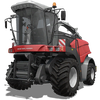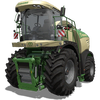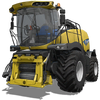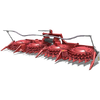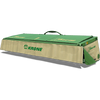Forage Harvesters/Farming Simulator 17
A Forage Harvester is a type of Vehicle in Farming Simulator 17. The primary purpose of a Forage Harvester is to collect Chaff, but it can also collect other types of materials - all of which a normal Harvester cannot collect. Forage Harvesters are very expensive machines, and should only be bought if you know what you intend to use them for.
In order to do anything, a Forage Harvester must be fitted with a special implement called a Forage Header. Different types of headers can perform completely different jobs on your fields, ranging from production of Chaff; to harvesting Poplars; and even picking up piles of Grass or Hay from the ground.
Unlike normal Harvesters, a Forage Harvester does not have an internal holding tank - It does not accumulate the material it cuts from the field. Instead, it must immediately dump the material into a Tipper or other container, while working. If no such container is present within reach of the Forage Harvester's pipe, the material will be completely lost. This requires either towing a container directly behind the harvester, or using a second vehicle to tow a container next to the harvester as it works.
Farming Simulator 17 offers three different types of Forage Harvesters. Despite what the in-game information suggests, any Forage Header can be connected to any Forage Harvester. However, the power consumption and shape of certain Forage Headers makes them awkward to use on the smaller Forage Harvesters.
List of Forage Harvesters
Below is a list of all three models of Self-Propelled Forage Harvesters available in Farming Simulator 17. All models can be found in the "Forage Harvesters" category at the store.
| Name | Price | Maint. Cost per Day |
Horsepower | Max. Speed (km/h) |
Fuel Capacity |
|---|---|---|---|---|---|
| Rostselmash RSM 1403 | 221,000 | 810 | 442 | 30 | 1,080 |
| Krone BiG X 580 | 275,000 | 980 | 580 | 40 | 1,220 |
| New Holland FR850 | 374,000 | 1,480 | 824 | 40 | 1,400 |
Additionally, the game provides one Forage Header model that turns any Tractor into a Forage Harvester - See Pöttinger MEX 5.
Forage Harvesting
Using Forage Harvesters you can get special materials from your crops that cannot be acquired by a normal Harvester. Depending on which Forage Header you use, and what kind of crop you use it on, you can get one of four different materials:
| Header Type | Input Crop | Output Material |
|---|---|---|
| Corn Chaff Headers | ||
| Universal Cutters | ||
| Pickup Headers | ||
| Poplar Headers |
As with Harvesting Headers, a wider Forage Header is typically better but more expensive. Also, you need to remember that smaller Forage Harvesters may struggle with certain models of Headers. Read individual articles on Forage Harvester and Forage Header models to learn which fits best.
Once you've purchased the correct header and attached it to your Forage Harvester, you also need to decide how you're going to collect the materials produced by the Harvester. A Forage Harvester does not have an internal tank, and cannot store any materials. Instead, you must purchase some sort of container - a Tipper or Loading Wagon - to hold the material. The larger the container you choose, the more you can harvest before it needs to be emptied or replaced.
After selecting your container, you must decide whether you want to tow it behind your Forage Harvester, or use a separate vehicle. Unlike a normal Harvester, a Forage Harvester can automatically fill up any container it is towing, so this is usually the best option. Alternatively, you can use a Tractor or other vehicle to tow the container next to the Forage Harvester while it works, as you would with a normal Harvester.
When both Header and Container are ready, drive your Forage Harvester to the field and hit the "Pipe Out" button. You can now turn on the Harvester itself and begin the forage harvest.
Your pipe will automatically point to the nearest container it can find (within a limited distance) that has room for more materials. It will automatically swivel as needed to track the position of any available container. Normally, it will first fill any container being towed by the Forage Harvester itself. If it can't find one (or it's full), it will look for any container being dragged alongside the harvester by another vehicle, or any other nearby container it can find.
If at any point during the harvest the pipe cannot find any available container nearby, any material you harvest will be completely lost. If this happens, make sure to stop harvesting immediately to avoid destroying your crops for nothing. Get a container near the harvester before continuing.
Towing a Container
Forage Harvesters themselves are quite powerful, and can tow their own Tippers or Loading Wagons, even the very massive ones. Each Forage Harvester has both Drawbar (Ball) and Drawbar (Bolt) attachments at the rear, which will hook up to most containers easily. Some models of Tippers even allow you to chain a few containers together - and the Forage Harvester will fill one and then the other automatically.
When towing a container with your Forage Harvester, make sure to stop as soon as the container is full. You can then detach the container, and use another vehicle to tow it away and replace it with an empty one, so that the Harvester can keep working. Alternatively, the harvester itself can tow the container away and hook up to a new one, then return to the field and keep working from where it stopped.
Secondary Vehicle
Alternatively, you can use a second vehicle - a Tractor, Truck, or anything else - to tow a container next to the Forage Harvester while it is working. This is the same process normally used for normal Harvesters, except the Forage Harvester absolutely needs the container to be present in order to harvest anything. Therefore, the secondary vehicle needs to keep up with the Forage Harvester at all times. It cannot leave the harvester's side until the container is full - at which point you should stop the harvester until an empty container can be brought up to continue working.
If you're using a powerful vehicle, you might be able to connect two or more containers behind it, forming a train. This way, once the harvester has filled up one container, you can accelerate your secondary vehicle a little so that the harvester can fill the second container. Again, only powerful towing vehicles can handle two (or more!) containers, so choose your secondary vehicle carefully.
Hired Workers
In Farming Simulator 17, you can use Hired Workers to automate your Forage Harvesters. They will behave the same way as they do with normal Harvesters. If at any point the Forage Harvester cannot find a nearby container to unload into, the Hired Worker will stop and wait.
Note that if you are towing your containers behind the Forage Harvester, you're going to need to dismiss the Hired Worker in order to detach the container and replace it with a new one manually. Hired Workers cannot do this themselves.
If you're using a secondary vehicle to tow a container, you need to keep up with your Hired Worker in the Forage Harvester at all times, otherwise he/she will stop whenever the container is too far away.
Note: While using a Pickup Header, you cannot hire a worker.
Field Dumping
If you want to speed up the process of Forage Harvesting, especially on a large field, consider dumping the contents of your container right there on the field every time it is full. In other words, once a container is full, immediately press the "Unload Here" button to dump the entire thing on the ground, creating a Pile. You can then immediately resume the harvest with the same container, without much down-time.
Of course, doing so requires you to later collect the materials from the ground back into a container. The best method is to use a simple Loading Wagon to easily suck up the materials from the ground. If you don't have one and cannot afford it, consider using some type of Loader or even a Conveyor Belt system to load the piles back into a Tipper. Since the harvest is already over, you are no longer under any real time pressure, so choose the method that works best for you.

